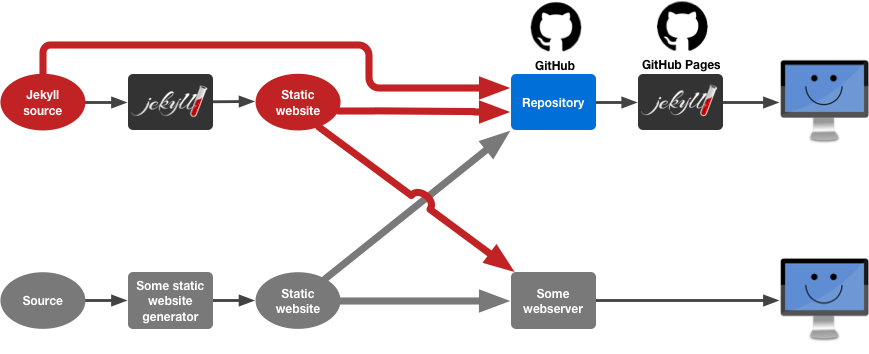Overview of GitHub Pages, the free static website hosting service of GitHub.
What Is It?
GitHub Pages is a free static website hosting service of GitHub. Every repository can provide one static website that is hosted for free.
The hosting can be enabled for a repository in the Settings of the repository.
The source of the static website (that is, which files are considered to be part of the website) can be either set to the master branch, the gh-pages branch, or to the docs folder of the master branch. All the files in the selected source location will be processed and served by the webserver.
How It Works

GitHub Pages runs Jekyll, a static website generator.
Jekyll converts Jekyll input (a mix of HTML, Markdown, SCSS, YAML configuration files, and Liquid) to a ready-to-serve HTML/CSS static website.
Any input that is not Jekyll-specific is copied unmodified to the output directory by Jekyll.
When you push to your GitHub repository, GitHub Pages runs all the files in the specified location (that is, the master or gh-pages branch, or the docs folder of the master branch) through Jekyll. The output of Jeykll is served by the webserver.
This can mean two things:
- If the content of your repository is Jekyll input, it is converted to a static website right there on GitHub, and this static website is served by the webserver
- If the content of your repository is already a ready-to-serve static website, it is not modified by Jekyll, and all your files are passed “as is” to the webserver
This means, there are several options to publish a website on GitHub Pages (as can be seen in above illustration):
- Create Jekyll input, push the Jekyll input to GitHub, and let GitHub Pages convert it to a static website with Jekyll
- Create Jekyll input, convert it locally to a static website, and push the static website to GitHub
- Create a static website with another static website generator, or manually from scratch, and push it to GitHub
- Of course, you can also publish the static website output that you generated locally with Jekyll on any other webserver
What’s The Address Of My Website?
After pushing to GitHub, the website is accessible under:
http://username.github.io/repository-name
User and Organisation Websites
In addition, every GitHub user and organisation can create one static website with the following address:
http://username.github.io
In order to create such a user or organisation website, the name of the GitHub repository must be username.github.io, and the GitHub Pages source must be set to the master branch. This is described here.